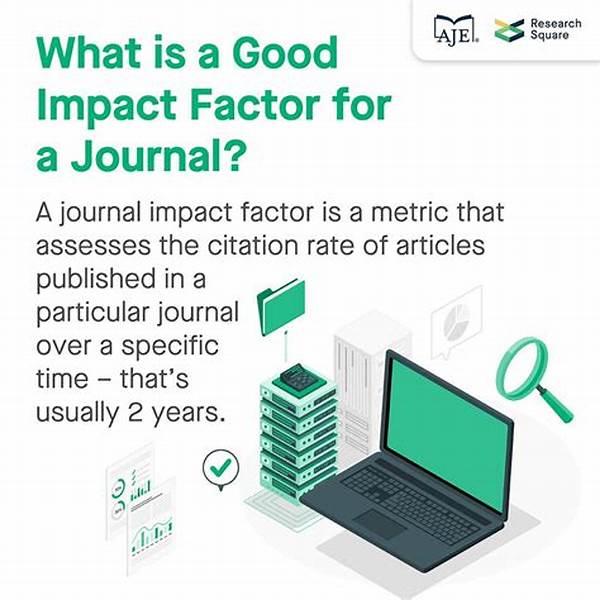The significance of high impact journal metrics in the academic and scientific community cannot be overstated. These metrics serve as benchmarks for evaluating the influence and reputation of scholarly publications, providing a quantitative framework to assess the scholarly contributions of researchers worldwide. As academia increasingly emphasizes evidence-based measurement of research output, these metrics have crystallized into vital components of academic evaluation, contributing directly to institutional rankings, tenure decisions, and grant allocations.
Read Now : Improving Research Accessibility Worldwide
Understanding the Significance of High Impact Journal Metrics
High impact journal metrics are pivotal in guiding researchers toward reputable sources within their fields. These metrics essentially measure the number and quality of citations a journal receives, serving as indicators of a journal’s prestige and the relevance of its published work. For authors, understanding these metrics can inform publication strategies, enabling them to target journals with the desired impact and readership. Institutions also utilize these metrics to support strategic decisions, enhancing their research profile and perceived status in the global academic landscape. Such metrics are not merely numbers but reflect the greater scholarly conversation, embodying the dissemination and influence of knowledge. They provide transparency and insight into how research shifts paradigms and addresses societal needs, thus reinforcing the importance of high-quality scholarly communication channels.
Key Components of High Impact Journal Metrics
1. Citation Analysis: High impact journal metrics are largely based on citation analysis, assessing how often articles within a journal are cited by other works.
2. Impact Factor: This widely recognized metric calculates the average number of citations to recent articles, serving as an indicator of the journal’s influence.
3. H-Index: A metric that balances productivity and citation impact of a journal, contributing to the assessment of both quantity and quality.
4. Eigenfactor Score: This represents the overall influence of a journal by considering the origins of citations, weighting those from prestigious journals more heavily.
5. Altmetrics: These provide alternative measurements beyond traditional citations, capturing social media mentions, downloads, and more, reflecting the broader impact.
The Evolution and Critique of High Impact Journal Metrics
The evolution of high impact journal metrics reflects the growing complexity and diversity of scholarly publishing. These metrics have evolved to incorporate not only citation counts but also newer forms of scholarly communication emerging in the digital age. The rise of Altmetrics, for instance, represents a shift towards acknowledging diverse forms of impact, such as social media engagement and public policy influence. Despite the empirical nature of these metrics, they are not without critique. Critics argue that an overreliance on high impact journal metrics may undervalue certain types of research, particularly interdisciplinary work or studies with long-term rather than immediate impacts. Furthermore, the pressure to publish in high-impact journals can lead to a competitive environment that may compromise research integrity and innovation.
Read Now : Multidimensional Data Analytics Strategies
Historical Context and Application of High Impact Journal Metrics
The Emergence of High Impact Journal Metrics
High impact journal metrics emerged in response to the need for a systematic evaluation of scholarly work. Traditionally, academic worth was assessed qualitatively, through peer reviews and expert assessment. However, as knowledge production expanded, metrics became essential for a more objective assessment. The creation of these metrics facilitated discernment of research quality amidst the vast array of published work. Indeed, they arose from efforts to streamline and quantify the effectiveness of knowledge dissemination.
Current Application and Challenges
In today’s academic realm, high impact journal metrics serve multiple purposes beyond simple evaluation. They inform hiring and promotion decisions within academia and guide citation practices and research dissemination strategies. Despite their utility, the challenges facing their application remain significant. Over-reliance on these metrics can lead to a narrow focus that sidelines impactful research which does not fit traditional academic structures. It is crucial for the academic community to balance the use of these metrics with holistic evaluations to nurture diverse and innovative research.
Conclusion on High Impact Journal Metrics
High impact journal metrics are indispensable tools in the modern academic landscape, providing critical insights and guidance for researchers, institutions, and policymakers alike. These metrics, while not without limitations, offer a framework to assess research contributions and facilitate the advancement of knowledge across disciplines. They embody the dynamic nature of academic discourse, capturing the relevance, influence, and reach of scholarly work. However, it remains imperative to approach these metrics with a critical perspective, ensuring they complement rather than dictate the narrative of academic excellence.
Future Directions in High Impact Journal Metrics
The future of high impact journal metrics lies in diversification and refinement. As the academic community shifts towards interdisciplinary and open access models, the evolution of these metrics must continue. Integrating alternative measures of impact, such as societal contributions and policy influence, will be crucial. Transparency in methodology and adaptability to the digital environment will drive the ongoing relevance of these metrics, helping to reshape the way scholarly achievements are recognized and celebrated.
Challenges in Implementing High Impact Journal Metrics
Despite their value, implementing high impact journal metrics poses significant challenges. Variability in indexing and inconsistent criteria among databases can lead to discrepancies. Ensuring fairness and accuracy necessitates rigorous methodological standards and regular updates to maintain their relevance. Furthermore, fostering a culture that values diverse research contributions while utilizing these metrics requires a nuanced approach. Balancing quantitative and qualitative assessments will help create a more equitable academic community that values all forms of scholarly impact.
